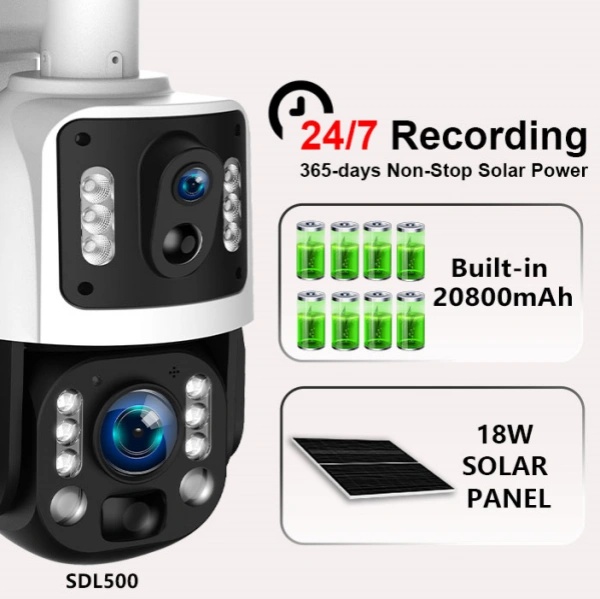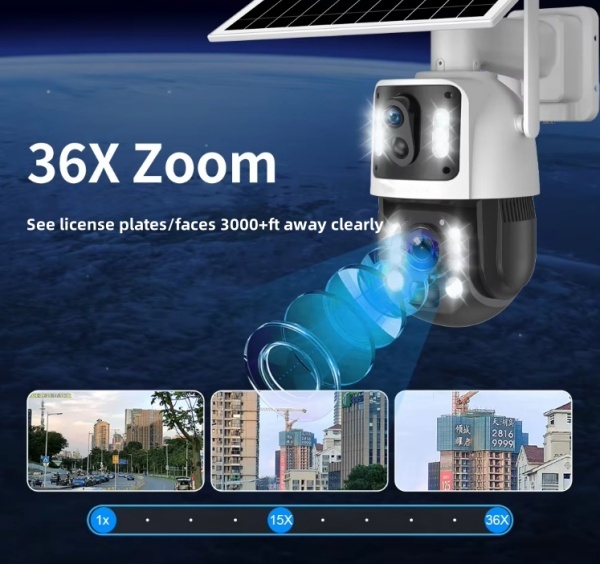How Much Sunlight Does a Solar Security Camera Actually Need? (An Engineer’s Guide)
“My farm is in a rainy region. Will a solar camera work for me?”
“What if I have to install it on a north-facing wall? Will the battery last?”
“In the winter, when the days are short, will it constantly go offline?”
As security product engineers, these are the most common—and most critical—questions we hear from customers. It’s completely understandable to be concerned about whether a solar-powered camera will be reliable in your specific environment.
The good news is that modern solar security cameras are far more intelligent and resilient than you might think. In this guide, we’ll give you a simple, direct answer and then take a deep dive into the science behind it, so you can make your choice with total confidence.
The Simple, Direct Answer: Remember the “2-3 Hour Golden Rule”
For a quick takeaway, here’s a solid rule of thumb: A well-engineered solar security camera only needs an average of 2 to 3 hours of direct, effective sunlight per day to maintain its charge for routine operation.
“Effective sunlight” means unobstructed sunlight hitting the solar panel. But this is just a baseline, and the reality is often even better. Why? Because a camera’s ability to be self-sufficient is never about a single factor. It’s about a powerful system of three core elements working in perfect harmony.
The Deep Dive: The 3 Core Factors That Determine Power Self-Sufficiency
Imagine a rainwater collection system. How much water you can gather depends not just on how much it rains, but on how big your collection funnel is (efficiency), how large your water tank is (storage), and how often you use the water (consumption). A solar camera works exactly the same way.
Factor 1: The Solar Panel’s “Appetite” (Wattage & Efficiency)
Not all solar panels are born equal. The panel’s power, measured in Watts (W), determines how efficiently it can convert sunlight into electricity in a given amount of time.
- A standard 5W panel: This is like a person with a small appetite. It takes a long time to get “full” (charge the battery).
- The 20W high-efficiency panel on a UBOXCAM SDL500: This panel has double the “appetite.” It charges much faster under the same light conditions. Even a short period of sun can rapidly replenish a significant amount of energy.
So What? A higher-wattage panel gives your camera a much higher tolerance for bad weather, allowing it to recover quickly after consecutive cloudy days.
Factor 2: The Battery’s “Water Tank” (Capacity in mAh)
If the solar panel collects energy, the battery is the “water tank” that stores it. The larger the battery’s capacity, measured in milliampere-hours (mAh), the more energy it can hold in reserve.
- A common 10,000mAh battery: This is a small tank. It might run dry after just two or three days of continuous rain.
- The 20,000mAh long-life battery in UBOXCAM models: This is a massive reservoir. When fully charged, it can power the camera in a low-power standby mode for 150 days, or even 180 days, with zero sunlight.
So What? A large-capacity battery is your peace of mind. It’s the buffer that ensures your camera stays on guard during extreme weather, like a long rainy season or a dark winter.
Factor 3: The Camera’s “Metabolism” (Power Consumption)
This is the most critical and often overlooked factor. A poorly designed camera will drain its battery quickly, no matter how big it is. Intelligent power management, however, gives a camera an incredibly small “appetite.”
The secret weapon is our PIR thermal detection combined with AI person/vehicle recognition.
- Traditional Motion Detection: This is like an over-sensitive guard that triggers an alarm and records video for every swaying tree branch or shadow, wasting huge amounts of power.
- PIR + AI Smart Detection: This system only reacts to the heat signature of a moving object (like a person or animal). The AI algorithm then confirms if it’s a target you care about (a person or vehicle). This ensures the camera only wakes up and uses full power when a real event occurs. For the other 99% of the time, it’s in an ultra-low-power “sleep” state.
So What? This extreme power-saving technology means your camera might only need to fully wake up a few times a day, minimizing daily energy consumption. This is the fundamental key to achieving true energy self-sufficiency.
Frequently Asked Questions (FAQ)
Q: What happens on cloudy or rainy days? Will it still work?
A: Absolutely. First, even on overcast days, the solar panel can still generate a small current to trickle-charge the battery. More importantly, this is where the large-capacity battery does its job. A fully charged 20,000mAh battery is designed for this, easily lasting through a week or more of continuous bad weather.
Q: What about winter, when there’s less light or the panel is covered in snow?
A: The low light and short days of winter are a challenge, but a 20W high-efficiency panel is designed to make the most of that limited sun. For snow, we recommend installing the camera in a spot where snow is less likely to accumulate, or clearing it off periodically. Because the camera’s power consumption is so low, the large battery provides more than enough buffer to get through the winter, even with reduced charging.
Q: Does it need direct sunlight? Can it work under an eave or in the shade?
A: Direct sunlight is always the most effective. Indirect light (like in a bright, shaded area) will still provide a charge, but the efficiency will be significantly lower. We do not recommend installing the camera in a location that is in deep shade for most of the day. If you must, try to ensure the spot gets at least a few hours of direct sun.
Expert Tips: 4 Secrets to Maximize Your Solar Charging Efficiency
- Face is Everything: In the Northern Hemisphere, face the solar panel due south to capture the most sunlight throughout the day.
- Get the Angle Right: Tilt the panel at a 30-45 degree angle to the ground. This helps it face the sun directly and allows rain to wash away dust.
- Keep it Clean: Periodically wipe the panel’s surface with a damp cloth to remove dust, bird droppings, or leaves that can block light.
- Optimize Settings: In the app, you can adjust the PIR detection sensitivity to a slightly lower level to reduce unnecessary wake-ups and save even more power.
The UBOXCAM Solution: Engineered for All-Weather Reliability
As you can see, a reliable solar security camera is never just a random collection of parts. It’s a precisely calculated and engineered system.
At UBOXCAM, our “Farm Guardian“ and “Site Sentinel“ series are built on this system-based philosophy:
- Massive Collection Power (
20W High-Efficiency Panel) - Huge Storage Capacity (
20,800mAh Long-Life Battery) - Minimal Energy Consumption (
PIR + AI Smart Detection)
These three elements work in perfect balance to ensure our cameras deliver the uninterrupted protection you expect, even when the sun isn’t cooperating.
Conclusion
So, back to the original question: how much sunlight does a solar camera actually need? The answer is: when you have a well-designed system, you have to worry about sunlight far less than you think.
Instead of worrying about the exact number of perfect sun-hours per day, choose a solution that has achieved the ultimate balance between collecting, storing, and consuming energy.
Click here to explore our solar security solutions and see how we prepare you for “just in case.”


